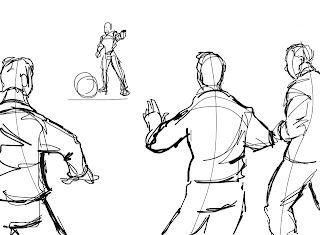When devising my brief it became apparent that it had to concern some of my methodologies, particularly their use under industry conditions. The chief way to do this was to push how much of a finished standard digital drawing could produce, whilst still adhering to the criteria of my principles.
Below is an overview of the brief requirements/criteria.
To go about this I decided that a ten panel storyboard would be sufficient to encompass all of my objectives. The first point of call was Compression. I had to identify the story elements; the cause, effect, solution, characters, etc. I also wanted to explore something a little more dynamic and visually fun, so I opted for a classic bomb scenario.
To enable a quick read and easy understanding of the narrative, I chose for obvious signifiers in characters. Innocent by-stander, thug/terrorist. For more opportunities to compose long shots, or tiered depth of field, the location of a street became a natural decision.
Brief evaluative stage outcome:
- Street location
- Gun-man antagonist
- Civilian protagonist
- Bomb device
With these elements in place, my second iteration categorized where my Three Pillars would be (as shown above), and where the Secondary frames would be. I even explored briefly the potential for sub-drama involving a flipping car.
Iteration 2. Line of Action.
Now it was time to flesh out the panels, this time taking into consideration the Line of Action. More importantly, the methodology of how the Line of Action can inform composition. As such, all framing and composition decisions were reliant on these strokes, as marked in a black thick line.
Here the Line of Action related less on frame division, and more the relationship between one line to the other. One arcs in tandem with the intruding arc of the other.
Second Iteration.
Brief evaluative stage:
- Dolly Zoom
- Depth of Field shot
- Symmetrical LoA composing flow
This time I re-approached the same panels and tightened the composition for each, even inserting some angle changes where necessary.
Digitizing the illustrations.
Third Iteration.
Using Procreate on the ipad, I started to sketch out the bare bones of the panels. Line of Action and Mark Making naturally came into play by general application.
The key here was to keep the illustrations loose and free. I was imagining this to be a brief to be completed in realtime, within a digital environment. No time to head back to the studio; but to render there and then digitally with ease.
The below panel shows particular use of the LoA in regards to establishing the layout very quickly, and without the need to render.
A little background detailing applied.
With this frame, I felt the biggest opportunity to really describe the background, middle ground, and foreground was here. In this way, I separated the illustrations into a similar category of layers. (This leads to my previous 3D project that enabled individual manipulation.)
Foreground.
Middle-ground. (I applied the colour red here quite simply because it was a nod to the Colour methodology, Inference. The red infers imminent danger.
Background.
A tighter shot of the antagonist.
As seen here, the original sketch's LoA arcs are left intact.
Final rendition.
Frame 1. Tilted angle, top shot. Gun-man shoots into the sky. (Identified as The First Pillar)
Frame 2. Wide. Street civilians become startled and alert to the gunman's presence. (Secondary beat)
Frame 3. Reverse angle. A lone civilian remains rooted, opposed. (Secondary Beat)
Frame 4. Over-the-shoulder. Gun-man threatens civilian. (Secondary Beat)
Frame 5. Tighter shot of gun-man, pointing gun off-frame. (Secondary Beat)
Frame 6. Medium wide. Civilian tackles gun-man swiftly. (Identified as the Second Pillar.)
Frame 7. They tumble to the ground, bomb center frame. (Secondary Beat)
Frame 8. CU. Bomb counter depletes. (Secondary Beat)
Frame 9. Dolly zoom, CU. Civilian cries out- (Secondary beat)
Frame 10. Wide. Bomb explodes, hurling civilian back by force. (Identified as the Third Pillar.)
Though not a wholesome narrative in itself- in that this sequence would naturally segue into a broader narrative; but as a segmented sequence with its own inner-narrative we can see Compression, Line of Action, and a subtle application of colour Inference. Even for Black and White storyboard artists, the easily applied colour to signify certain themes becomes just as economical when digitizing. The editing process is tremendously cut short, enabling easier corrective steps and iterative reproductions.
Final evaluative outcome:
- Compression application; Three Pillars, Secondary frames.
- Line of Action informs composition
- Colour signifiers can be appropriate to Black and White Storyboarding




































No comments:
Post a Comment